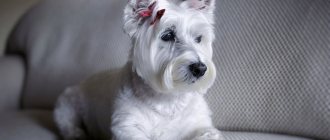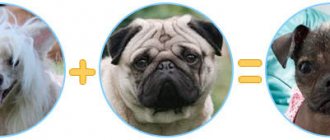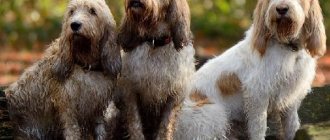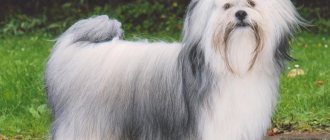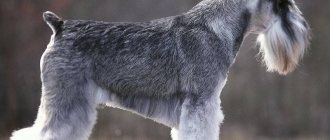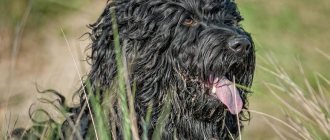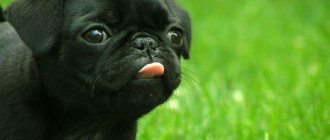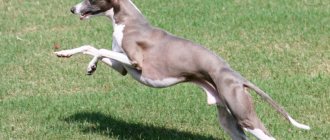Brief characteristics of the dog
- Other possible names: Icelandic Spitz, Icelandic Sheepdog, Icelandic Sheepdog, Farehond Friaar Dog, Icelandic Fairhund.
- Adult height: from 42 cm to 46 cm.
- Weight: from 10 to 15 kg.
- Characteristic color: red and white.
- Coat length: short or long, fluffy.
- Life expectancy: 12-14 years.
- Advantages of the breed: friendly, intelligent, inquisitive, active, hardy.
- Difficulties of the breed: the long-haired species requires care.
- Average price: $300-$500.
Breed characteristics
Height at withers: males – 46 cm, females – 42 cm.
Weight: 10-16 kg.
Color: shades of orange, black and tan (tricolor), gray, chocolate brown. White spots of small and medium size on various parts of the body are acceptable. A large amount of white, black back of red dogs, solid black color are considered defects.
Dewclaws: necessarily double, like the fifth toes.
Eye color: dark brown, may be slightly lighter in chocolate-colored dogs. The color of the eyelids and lips is dark brown.
Nose color: black or dark brown with chocolate coat color.
General appearance: dogs of an elongated format with a deep chest, females are more fragile than males. The ears are erect, triangular in shape, the tail is curved in a ring. Energetic and easy movements. The coat is either short or long, but with a thick undercoat. The muzzle is wedge-shaped.
History of the origin of the breed
The Icelandic dog, also called the Icelandic Shepherd, appeared on the territory of Iceland in the 9th century along with the Vikings who came from the Scandinavian Peninsula. Easily settling into the new territory, the dogs helped their owners hunt local game.
After cattle breeding began to develop on the island, Irish shepherds had to retrain as shepherds, who in the fall gathered the herd that had wandered across the pastures over the summer and brought it home.
In the 10th century, these dogs were brought to the British Isles by the Icelandic Vikings, where they became the progenitors of such famous breeds as Welsh Corgis and Collies.
In 1972, the Icelandic Shepherd was recognized by the Fédération Cynologique Internationale (FCI), and the first breed standard was issued at the same time, which was finalized in 2007. And in 2010, the breed received recognition from the American Kennel Club.
The Icelandic dog represents the Spitz group, which includes about 50 breeds.
About the breed
This animal belongs to one of the varieties of herding dogs. Her tasks:
- grazing and protection of livestock;
- searching for lost animals.
Externally, the Icelandic Shepherd is similar to the Finnish Spitz and the Norwegian Buhund. Today, in its homeland, this pet is most often acquired as a companion.
These dogs are not predisposed to creating conflict situations with others and have a fairly high level of insight. It is worth noting that these animals perform well as nannies, as they get along well with children.
There is an opinion that the early ancestors of these animals were brought to the territory of modern Iceland along with the Vikings. But is this really so?
Purpose of the breed
Icelandic dogs are almost never used for their original purpose, that is, they can rarely be seen hunting. But in some areas of Iceland they still occasionally herd livestock.
A good sense of smell allows, in some cases, to use Irish Shepherds to search not only for animals, but also for people. Most often, they serve as simple pets, and sometimes as vigilant watchmen. They are also regulars at exhibitions and participants in various competitions.
Nutrition
It is recommended to feed the dog premium dry food. Firstly, it is simple and does not require special preparation or calculation, and secondly, the food is already balanced, it contains everything a pet needs.
Adult dogs eat 2 times a day, small puppies 3-4 times. With age, the number increases, but the frequency decreases.
When feeding dry food, be sure to provide access to clean, drinking water.
Exclude from consumption: fatty meat, river fish, bones, sweets and flour. As goodies - cheese, pieces of boiled chicken.
Description of the nature of the breed
Icelandic dogs have practically no disadvantages . These cheerful and kind dogs do not know what aggression and mood swings are . They have a peaceful attitude even towards strangers , however, they will definitely notify the owners with their barking if guests appear on the doorstep.
Icelandic Shepherds are very inquisitive and try to stick their nose into everything. They are small, energetic and big fans of play . They can even chase pets not out of anger, but for fun. Such cheerful pets will always be happy to keep your child company . boundless devotion and obedience to you and the whole family .
Icelandic Shepherds are in great need of companionship and attention from humans and cannot be left alone for long. It is impossible to lose sight of these dogs, since they will remain near you without any commands, while trying not to get in the way, which is not always possible. They will even sleep at your feet.
Their developed intelligence helps them quickly learn and remember commands, and they can be easily trained in many types of dog sports.
Character
Unpretentious, loyal, playful dogs. Medium active, they love to be around people and are incredibly loyal, making them ideal family dogs.
The downside is that without companionship, they get bored, don't like to be left alone for long periods of time, and need more attention than other dog breeds.
In addition, such sensitivity affects training and one cannot be particularly strict with them.
Training should be consistent, but gentle and begin as early as possible. The Icelandic dog is smart, but matures emotionally later than other breeds.
The puppy's development continues until the second year of life. Proper training and adequate socialization are important for Icelandic watchdogs.
The attachment to people continues and for strangers dogs often greet them as friends. When scared, they growl and simply run away rather than engage in conflict. But usually they just want to make friends and are not well suited for security duty.
Puppies that have been raised without proper socialization may be aggressive towards dogs of the same sex, but they are usually peaceful.
Created for work and accustomed to harsh climates, these dogs suffer from excess energy in apartment conditions. Work is what they need to maintain physical and mental health. Moreover, they are easy to train and love to learn.
Despite their small size, they need space to run and be active and do best in a private home with space for other animals.
They are suitable for active families or singles, those people who want a dog to be their faithful companion and ally. Icelandic Shepherds love water, swimming, and some even try to play with their water bowls.
As a herding dog, the Icelandic often uses its voice. Barking is part of their nature and they successfully express different emotions with them. Take this fact into account, as they may not be very pleasant neighbors.
In addition, these are real escape artists that no fence can stop.
Overall, the Icelandic dog is a sweet and loyal companion who loves making friends and spending time with family. When necessary, she works hard, and when at home, she enjoys socializing. They are ideal for active, curious people living in a private home.
Choosing a puppy
Icelandic dog puppies are small, plump dogs with fluffy and soft fur . Most of the dog is colored red, and the fur on the chest, paws and belly is white. On the wedge-shaped head, erect triangles of ears and small, dark, round eyes are located high.
If the puppy is not bothered by anything, then the tail curled like a donut will be located on the back, and not hang down. In addition, the naturally inquisitive puppies of this breed, when they see you, should immediately confidently run up to meet you. They should not be scared or aggressive.
By two months, which is the age at which it is recommended to purchase a puppy, all necessary vaccinations must be completed and all documents must be completed. After purchase, conscientious breeders should give you recommendations regarding feeding in the first few days.
How to choose a puppy
Puppies of this breed are very inquisitive; when a stranger appears, they immediately run towards them, trustingly directing their gaze to the newcomer and wagging their tail.
- You should not buy a scared, aggressive baby.
- If the animal's tail is lowered, this indicates that it is sick, something is bothering it.
- Choose a puppy with a cheerfully raised tail, he is quite healthy.
- You should purchase a little guard when he reaches two months of age. All required vaccinations must be completed.
Dog names
The dog hears its name more often than other commands. In addition, you also say it quite often when you want to call your pet or give him some kind of command. Therefore, it should suit both of you. Below are several possible names for an Icelandic dog:
- for a male dog the following are suitable: Dublin, Saigur, Shamrock, Patrick, Haydar, Fel, Kron, Bowil and so on;
- for bitches: Bassie, Malla, Fabby, Tora, Yusi, Hella, Dakki, Gracie, Sharon and other similar names.
How to keep an Icelandic dog
It is quite difficult for this animal to adapt to the urban environment. Living in an apartment all the time leads to stress.
For this reason, it is recommended to keep such pets in areas with their own yards, which provide the opportunity to quietly run and frolic. In the absence of a private home and living in an apartment, the pet should be out for a walk from 1.5 to 3 hours a day.
It is also worth noting that this breed is perfectly adapted to any weather conditions. During the cold season, wool retains heat and prevents freezing. During hot periods, it protects from direct exposure to ultraviolet rays, maintaining a normal temperature and preventing overheating.
Thanks to the thick undercoat, the animal's skin almost never gets wet.
Care and maintenance
Both short-haired Icelandic dogs and pets with longer hair do not require any special or time-consuming care . The main thing is to keep the dog clean, which includes examining and cleaning the ears, trimming the nails (if the dog spends little time outside and they do not have time to wear down). If there is such a need, then you need to wipe your pet’s eyes.
Icelandic Shepherds, like many dogs, are subject to shedding, and not just seasonally. To ensure that your carpets are not covered with a layer of wool, your pet needs to be brushed regularly with a special brush. And to ensure that your dog is not bothered by fleas, purchase a soaked collar or regularly treat the fur with suitable products. In addition to skin parasites, there are also worms, which also need to be combated, but it is better to take measures in advance and treat the dog with the necessary medications.
Thick and dense hair allows the Icelandic dog to stay outdoors for a long time and tolerate cold weather well. She, of course, does not need an enclosure, but the opportunity to move freely around the yard will be received with great pleasure, since over many centuries they have become accustomed to freedom.
Icelanders can also be suitable for city apartments. But in this case, you need to immediately wean the dog from shitting indoors and asking to go outside. Such dogs need movement, which means they will have to be walked for a long time every day, giving them the opportunity to run without a leash.
Character and behavior
Judging by the description of Icelandic Sheepdog breed experts, these dogs are not capricious in everything. They perceive life as a holiday. They always have joy and friendliness shining in their eyes. Modern dogs have inherited from their ancestors the ability to protect. Once upon a time, shepherd dogs searched for lambs lost in the snow and protected them from attacks by birds of prey. Now they also have the habit of being vigilant and observing what is happening around them. Dogs will always rush to protect their owner, his children, a puppy or a kitten in a moment of danger.
Without training or training, they will be able to open the door of a bedside table or cabinet just to find out what is inside. During a walk, the pet will never go far from the owner, always watches him and comes running at the first call.
Dogs cannot stand being alone; from puppyhood they must be taught that people can go somewhere. Otherwise, the pet will perceive parting with people very painfully. A dog living in an apartment must be provided with toys during absences, otherwise the neighbors will begin to complain about his incessant whining and barking, and the Icelanders have a ringing and loud voice. The best place to keep it is a country house with an outdoor enclosure, a booth and plenty of space for walking.
Nutrition for puppy and adult dog
Feeding dogs with ready-made, dry or canned food . And for good reason. They are well balanced and filled with the necessary elements. When choosing this type of feeding, focus on the pet’s needs, and most importantly, on the quality of the food. By chasing cheapness, you risk significantly deteriorating your dog’s health. And some types can even cause cancer or kidney disease.
If you still decide to feed your Icelandic dog natural food , then check out the list of suitable products:
- lean meat (everything except pork) and various offal;
- sea fish without large bones or minced fish;
- various cereals, including mixtures;
- vegetables as an addition to the main menu;
- boiled eggs;
- fermented milk products (kefir and cottage cheese).
An adult dog needs to be fed twice a day , controlling the portion size. Puppies up to seven months require 3-4 feedings a day .
During the hot season, dogs' appetite decreases , and sometimes they even refuse to eat. Bitches have the same problems during estrus.
If your dog hasn't finished eating, always put away the bowl of leftovers until next time. This way you will teach her to feed at a certain time.
Features of care
Icelandic dogs are completely unpretentious in grooming.
Hygiene
The complex of hygiene measures includes:
- weekly combing to prevent the formation of tangles (more often during active molting);
- water treatments 1–2 times a year using zoo shampoos;
- examination of the ears and eyes once every 5–7 days, cleansing of secretions using a veterinary lotion, herbal decoction, etc.;
- shortening the claws, if they do not grind down themselves, using a nail clipper;
- brushing teeth once every 7–10 days with a special toothpaste for animals and a finger brush.
Walk
Active and energetic Spitz dogs need long (2-3 hours) daily walks, where they can satisfy their thirst for movement. This breed is suitable only for active people who can provide their pets with the proper level of physical activity, taking them with them on bike rides, morning runs in the park, trips to the mountains, trips to nature and other outdoor activities.
Icelandic Spitz needs to exercise a lot
Nutrition
Owners usually try to feed native dogs home-cooked, freshly prepared food, but store-bought freeze-dried food is becoming increasingly popular. Experienced dog breeders advise choosing products of at least a premium class, intended for active and active dogs:
- Hill's Science Plan Performance;
- Royal Canin Sporting Life Trail 4300;
- Purina Dog Chow Active;
- Pro Plan Adult Performance.
Pro Plan Adult Performance is designed for adult dogs with particularly high levels of physical activity.
The natural diet consists of:
- sea fish without bones or minced fish;
- lean meat (veal, rabbit, etc.);
- offal (trimmings, tripe, kidneys, etc.);
- seasonal vegetables and fruits, herbs;
- eggs;
- fermented milk products with reduced fat content (ryazhenka, cottage cheese, etc.);
- cereals (buckwheat, millet, etc.);
- vitamin and mineral supplements.
It is forbidden to give shepherd dogs pasta and bakery products, smoked meats, sweets, as well as fatty foods and hollow tubular bones.
Briefly about training
The Icelandic dog is very easy to teach all the required commands. Nature has endowed them with remarkable intelligence and excellent memory .
They perceive the entire educational process as part of a game, and therefore they will gladly carry out what is proposed, especially if success is reinforced with treats and praise from their beloved owner. In addition, they will gladly accept the offer to engage in sports such as fly-ball, agility and many others.
Education and training
Dogs from Iceland have a lively mind, are observant, flexible, and are easy to accustom to everyday life. Puppies quickly socialize and learn hygiene. Dogs can be both beloved companions and household helpers. They quickly remember commands and carry them out with joy. For them, learning is more of a game than a responsibility.
Note! The physical characteristics of Icelandic Shepherds allow them to participate in freestyle and agility competitions.
Advantages and disadvantages
Icelandic Shepherds are excellent family dogs with virtually no faults . They are incredibly loyal and so attached to a person that they always try to be as close to him as possible. True, sometimes they can get in the way and get under your feet.
The desire to please and high intellectual abilities allow the Icelandic dog to learn quickly and remember everything well . And activity and mobility often make her a champion in various types of dog sports.
But such an energetic dog requires long daily walks. Therefore, it is not suitable for sedentary people , or as a sofa pet.
These are very cheerful and cheerful dogs who love to frolic and play . Often other pets also participate in these games, on which, even during entertainment, the Icelandic Shepherd shows its herding instinct, not allowing them to leave the territory and trying to keep everyone in one place. The same applies to children, with whom such a pet has a wonderful relationship.
The Icelandic Sheepdog does not forget about protecting its territory. She will always notify the arrival of guests, and in some cases she will be able to bravely protect the owners from uninvited strangers . Although the dog treats strangers with some distrust, when he sees the joy on the owner’s face, he immediately becomes peaceful and affectionate.
These dogs are very dependent on human communication and have difficulty withstanding loneliness . And some breeders even recommend trying to give such a pet as much attention as possible until the age of eighteen months, gradually teaching it to be left alone.
Icelandic Shepherds are affectionate and loving . They know how not only to receive, but are also ready to give all their tenderness in return and become a faithful companion for their human family.
Care
These are fairly unpretentious animals to care for. The maximum that is required of you is infrequent washing as needed, brushing once a week (more often during the shedding period) and minimal ear care. You should also keep an eye on the claws. And don't forget about regular flea and tick treatments. But most of these recommendations are relevant for all breeds, so we can say that the Icelandic dog does not need any special care - after all, it is a Viking dog!
Hygiene
Grooming involves periodic brushing. Regularity of the procedure will reduce the likelihood of matted fur and remove accumulated dirt. It is enough to brush your Icelander once a week. But during the molting period (spring and autumn), the procedure must be carried out more often. Grooming of this breed is not practiced.
Nails are trimmed as they grow. Do not neglect the procedure, because there are often cases of claws growing into the fingertip.
Washing your dog frequently is not recommended. Frequent bathing leads to the fact that the natural protective fatty film on the animal’s skin is washed away. As a result, the skin becomes dry and irritated, and the dog’s resistance to frost decreases.
It is necessary to clean the ears 3-4 times a month. The eyes are rubbed as discharge appears on them.
To prevent the appearance of fleas and ticks, it is necessary to use special collars or repellents (insect repellents).
Hygienically, caring for an Icelandic dog is kept to a minimum: regular brushing, ear cleaning and nail trimming.
Walking and exercise
Icelandic dogs cannot live without movement, they have a lot of energy and if they do not splash it out, they will begin to become decrepit early, although the average life expectancy of these dogs is 14 years. Therefore, daily 2-hour walks are mandatory.
There are practically no genetic diseases in this breed. Sometimes cases of hip dysplasia are detected, but treatment of the disease with timely consultation with a veterinarian occurs without complications. Older Icelandic Shepherds are prone to eye problems. Dogs are vaccinated according to a schedule agreed with veterinarians. Vaccinations against rabies (at 6 months), against plague, parovirus (at 6-9 weeks), a second vaccination against rabies and leptospirosis (at 12 months) are required.
Nutrition
In general, it is noted that animals belonging to the Icelandic breed are not demanding in relation to their diet. However, even despite this, you cannot neglect planning your four-legged friend’s meals and feed him scraps from the master’s table. It should be remembered that one way or another, the animal’s nutrition should be healthy and balanced. Try to saturate it with the maximum possible amount of useful components that will ensure the active growth and development of the animal.
As the basis for your pet's nutrition, you can choose ready-made dry mixtures and food that are sold in pet stores and zoological markets. This option may seem more convenient and comfortable for those who do not like to cook and want to make the task of providing food for their pet as easy as possible.
However, if you choose this option, then before buying this or that food, you should consult with a specialist in advance and find out whether it is suitable specifically for your pet . In addition, in this case you will need to purchase various nutritional supplements and vitamins necessary for the animal’s body.
The second option is considered more budget-friendly, but it is time-consuming. So, you can feed your Icelandic Shepherd with natural products that you eat yourself. The dog's diet should consist of cereals, vegetables, fruits, dairy products, as well as lean meat and fish. Remember that when choosing natural food, you must prepare food for your dog separately. They must be fresh and of high quality. Under no circumstances should you give your pet expired, spoiled or stale food. You should also avoid feeding him scraps from your table.
Owner reviews
Elena:
In my opinion, the dog is simply excellent. She easily learned everything that was required of her and now understands us literally from half a word. The only thing we can’t wean off is getting underfoot. Sometimes such attachment is very disturbing. Incredibly energetic. It’s good that we live in our own house, and she can always run freely around the yard. I can’t imagine how they live with her in apartments. But at the same time, she is very cheerful, cheerful and kind.
Dmitriy:
As for me, this breed should not be called a shepherd. I have something to compare with, since I have both a German and an Icelander living with me. The difference is colossal. The only similarity between them is intelligence and obedience. Although the Icelander has his charms. He is very funny and playful. But his habit of always being nearby is sometimes very intrusive and even interferes and irritates. But overall the dog is good. Loves children and enjoys spending time with them. It was funny to watch how he tried to collect all the kittens in boxes, and then also dragged their mother so that he could better keep an eye on them.
Catherine:
Our Zyuza is already four years old and the whole family adores her, especially since in return she gives us a sea of positive emotions. She is also an excellent athlete and we rarely return after competitions without a reward. We live in an apartment. This does not cause any difficulties or problems. The main thing is to properly care for it and walk it often. She has her own nook and several toys with which she entertains herself in our absence. Caring for such a dog is absolutely not difficult. There is no need to drag her around to groomers or spend hours getting her in order. I'm not picky about food either. And our cat Vaska is her best friend.
We are waiting for your reviews and stories about this small Icelandic dog, endowed with a kind and loving heart. Share your impressions and emotions from these loyal and affectionate animals.
Share
Leave a review
Health and life expectancy
The Icelander is a healthy animal with a good immune system, he rarely gets sick and is practically not susceptible to inflammatory diseases.
Genetic predisposition and consequential factors include:
- Problems with the musculoskeletal system, often joints;
- Hip dysplasia;
- In older age – cataracts;
- Problems with excess weight;
- Allergies;
- Endocrine disorders in bitches after childbirth.
Life expectancy with proper care and proper nutrition is up to 14–15 years. It is important to adhere to a physical activity regimen to avoid problems with excess weight.
Best nicknames
Abroad, male Icelandic Shepherd puppies are called Basti, Kniff, Vinsett, Dayron, Vesamont, Brusik, Lauren, Alfred. For girls, the nicknames Zukhra, Malibu, Melena, Gafa, Ailanta, Zhunya, Indy were invented.
Dogs of any breed that are liked by their owners will always be the most beloved, despite all their shortcomings. But dogs of the Icelandic dog breed have practically no disadvantages, except for two - they cannot be bought in Russia and they bark very loudly and loudly.
But the dogs have a unique character. They are friendly, sociable, easy to train, love people, and with proper upbringing they completely obey their owner. Probably many would like to have such dogs.
Health
This breed is characterized by good health. However, common health problems include:
- Dislocation of the knee joint;
- Dysplasia of the elbow, hip joints;
- Eye diseases in older adults.
Vaccination
Vaccination is carried out according to the following vaccination calendar. But changes can be made individually for each individual.
| Age | Vaccination |
| 6 weeks | Parvovirus, plague |
| 8-9 weeks | Plague, parvovirus, hepatitis, parainfluenza, adenovirus |
| 12 weeks | Revaccination |
| 6 months | Rabies |
| 1 year | Leptospirosis, rabies |
| 3 years | Full revaccination, including against leptospirosis and parainfluenza, annually |
History and appearance of the breed
In the long history of the icy island nation of Iceland, the dogs, which the local population gave the name Islenskyr Fjarhyndur (Icelandic shepherd), have always been close to people. Islenskur fjarhundur's roots are in Denmark and Sweden. In these countries, burials dating back to 8 thousand years BC were excavated. e, in which the remains of dogs were found that were genetically similar to modern Icelandic Shepherds.
Icelandic Sheepdog
In the 16th century, Icelandic Sheepdogs were taken to England. It is not known for certain whether British dogs were crossed with Icelandic Sheepdogs at that time. Most likely no. After all, by origin, the modern purebred British Shepherd is more of a collie, and the Icelandic Shepherd is more of a Spitz.
In medieval Britain, Icelandic dogs were very popular, loved by English gentlemen and ladies of high society. In the play of the famous W. Shakespeare “Henry V” there is a mention of these animals.
English Shepherd
Breed standard
Icelandic Sheepdogs are a very old breed, based only on local animals. The first breed standard was registered in 1887. In 1901, the import of dogs of other species to the island was prohibited and work to improve the breed continued. In the 50s of the 20th century, several island shepherds were exported to the United States. People began to learn about Islenskur fjarhundur in other countries.
In 1960, at the English annual dog show Crufts, held by the English Kennel Club, shepherd dogs from Iceland received the title of best breed in show. In 1969, the breed was recognized as cultural heritage of Iceland. In 1996, the international organization Icelandic Sheepdog International Cooperation was created, which keeps records of born Icelandic Sheepdogs.
The Iceland Sheepdog breed standard is assigned No. 1.28 WKU. The latest addition to the standard was made on 03/06/2014. Icelandic dogs according to the WKU (World Kennel Union) classification are classified into group 1 - shepherd dogs.
Important! In 1972, the breed was classified by the FCI as guard and herding dogs.
The Icelandic Sheepdog is not afraid to ride on the back of a horse.
Appearance
In appearance, shepherd dogs from Iceland resemble Welsh Corgs - the favorites of the Queen of England and the smallest shepherd dogs in the British Isles. Dogs have approximately the same body weight - 10-15 kg, but Icelanders have longer legs and therefore their height at the withers can reach 48 cm, and not 30 cm, like Corgis. In height, Icelanders are close to Malinois shepherd dogs - herding dogs from Belgium.
The Icelandic dog has a fox-like muzzle. Dogs have protruding, straight, triangular ears, wide at the base, lips that fit tightly to the muzzle. A dog's nose can be black or dark brown. The bite of the teeth is scissor-shaped. The eyes are small, round, dark.
Shepherd dogs from Iceland have a strong neck, a short strong proportional body, muscular withers and limbs, a strong back, an elastic lower back, a wide chest and croup, a well-tight stomach, and oval-shaped paws.
The dogs' tail is set quite high; they hold it curled into a ring above their back. The body and tail of dogs are covered with thick hair. According to the quality of the surface coat, shepherd dogs can be short-haired, with a slightly coarse coat of medium length and a soft, dense undercoat, or long-haired, with a very coarse coat and a soft undercoat. The length of the hair on the face, ears, and front legs is shorter than on the neck, behind the ears, on the chest, hips, and hind legs.
Curled fluffy tail, erect ears - purebred Icelandic dog
The following coat colors are allowed:
- ginger;
- yellowish-fawn;
- wheat;
- zonal-wolf with black tips of hair and small white markings.
Note! Cropped or drooping ears and tail are disqualifying characteristics.
Behavior and temperament
Icelandic dogs are incredibly resilient and proactive . Energetic and strong, the animals are quite suitable as shepherds. It should be noted that this breed is completely unsuitable for hunting. Having a cheerful temperament, dogs always kindly greet guests, flirting a little and not showing a bit of aggression.
The animal has a serene, peaceful and cheerful character. The obedient and affectionate dog easily gets along with other animals and gets along unsurpassedly with small children. If there is no threat to life, they almost never show anger. They quickly get used to people and love being in company. If such a dog is left alone for a long time, he will be very worried.
